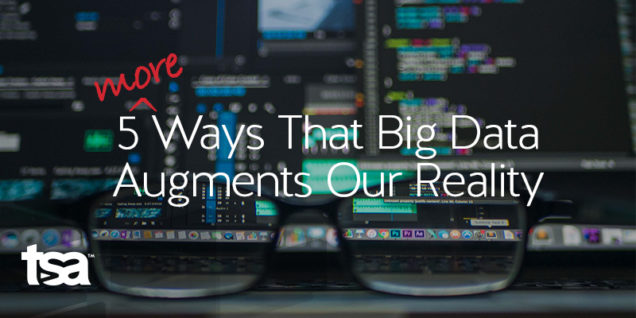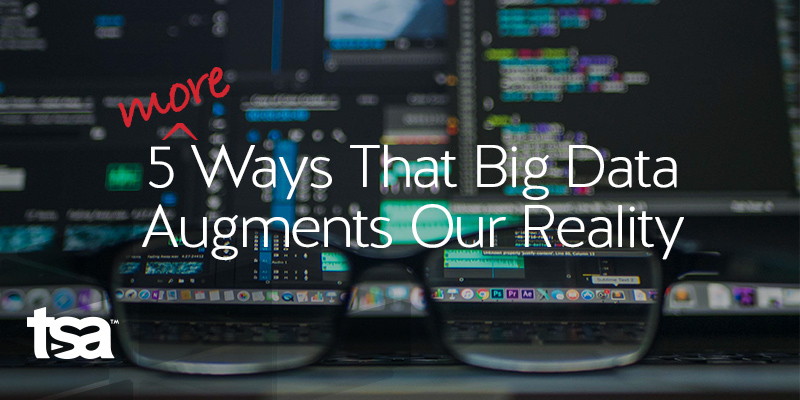As we mentioned before, there are seemingly limitless ways that Big Data can augment our realities, and we believe that it is important for you to understand how these analytics work behind the scenes in our everyday lives.
If you have read the previous post, then you hopefully noticed the undeniable trend that runs throughout the list—that Big Data not only keeps end-users up to speed, but it also keeps us ahead of the curve, no matter what industry or line of research we find ourselves in.
Big Data Promises More than Knowledge…
Medical Records and Research
The methodologies of healthcare professionals are seeing drastic reform due to the offerings of Big Data. With secured cloud-based archives now available them, physicians can more easily access their patients’ medical records and track any progress or regression of health, ultimately reducing margin of error. Moreover, thanks to analytics, doctors can more readily recognize patterns and signifiers within patient data and come to a faster, more conclusive diagnosis and treatment plans. In the same way, researchers can track and detect data trends in medical studies—for maladies like cancer, genetic syndromes, and heart disease, etc.—more meticulously and completely than before.
Wearable Tech
Big Data is the driving force behind the “medical IoT” of wearable tech and other smart devices (fitbit, Apple Watch, Mbody, Digitsole, etc.). The sensors within these wearables can report real-time data back to both the end-user and healthcare provider alike. These reports can be as mundane as tracking a child’s sleep patterns or monitoring an athlete’s heart rate during a workout, but they also can be more seriously utilized within the medical realm. For instance, Google Glass increases the accuracy of surgical procedures, “bio patches” record and report patient vitals, and (while, admittedly, this isn’t exactly a “wearable”) capsule endoscopy cameras provide more information while reducing patient discomfort.
Crime
Law enforcement officials across the globe are beginning to recognize the usefulness of Big Data technologies. Before, criminal records were often siloed to the region of particular criminal events. Connections between county and state lines—not to mention international borders—were difficult to make. Now, due to the aggregation of criminal data, these records are now made globally available, and long-standing criminals are being detained retrospectively as new technology emerges. In the long run, these are analytics that can create safeguards for human life. Moreover, Big Data can be used to actively track the movements and records of criminals, giving law enforcement a “bigger picture” of their current suspects. From the historical record and its real-time reporting, Big Data analytics can also predict the likelihood of criminal activity in both individuals and people groups.
Energy and Power
With the recent push for a greener, more sustainable earth, businesses are often on the lookout for more economical solutions to their energy consumption. Now, with Big Data’s tracking and analytical abilities, companies—and smaller entities—can assess their energy usage and make changes where wastages are flagged. This real-time reporting also better informs energy companies on the fluctuations of regional consumption, allowing them to provide more efficient services to their client base. But Big Data can be utilized even further back up the energy chain than just consumption—its analytics can be used to create anything from more accurate exploration and drilling initiatives to the most ideal grid arrangements for a wind farm. Big Data has proven itself to be an integral part of environmental conservation as well as a mechanism in the improvement of living conditions around the world.
Weather Forecasting
Weather forecasters have an unfortunate bad rap for not being entirely accurate or consistent in their prediction. And while Big Data can’t perfectly predict the unruly laws of nature, its analytics can certainly augment the processes that have been in place since the first publication of the Farmer’s Almanac in 1818. Weather channels and apps are convenient for planning whether you need to wear your rain boots on a certain day, but they also pose as life-saving alerting and preparation tools in the face of natural disasters. 2018 has already seen its fair share of tornadoes, earthquakes, wildfires, and volcanic eruptions, and while Big Data obviously is unable to stop these tragedies from occurring, its tracking and recording algorithms more accurately inform those who are in the path(s) of potential danger.
…Big Data Enables Smarter Decisions
And the trend continues.
We’ve seen how Big Data helps to increase data security, create greater profit margins, and improve corporate efficiency. Today, we also have been given just a small glimpse into the extensive life-changing-and-saving potential that these analytics grant us through augmented healthcare, enhanced criminal reporting, and more accurate natural disaster alerts. However, because Big Data is woven so subtly into the fabric of our lives, it is easy to misunderstand how powerful of a role it plays. Life before Big Data was entirely different than what we are able to experience today.
At TSA, we believe that the better we know you, the better we can serve and partner with you to help you reach your goals. With the combined help of powerful analytics and Big Data innovators like HPE, we work to improve your business by solving problems with the right technology. And helping you use Big Data effectively is an important way that we do it.

